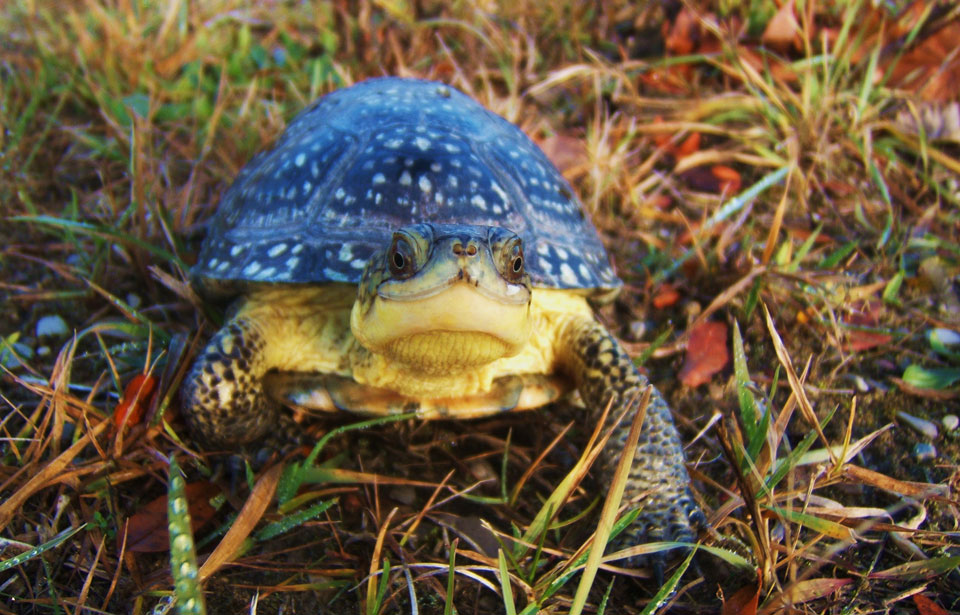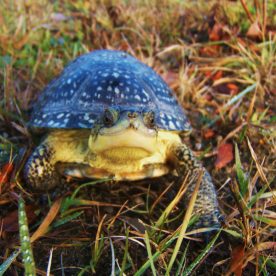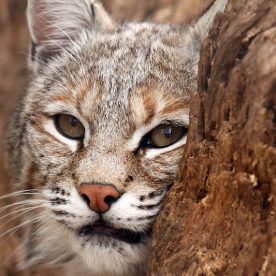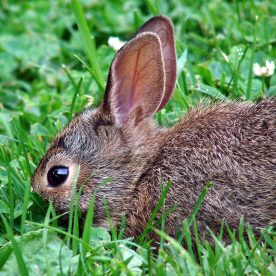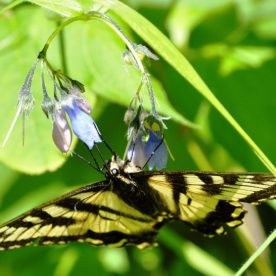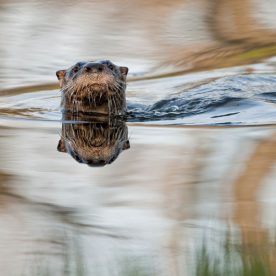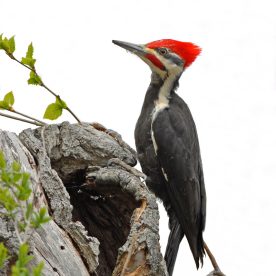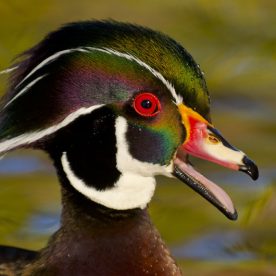Biodiversity
What is biodiversity?
In 1992, Canada ratified the United Nations Convention on Biological Diversity, as did many other countries. This convention is necessary because the present rate of loss of biological diversity, or “biodiversity,” is a serious global environmental threat.
Biodiversity means the variety of life on Earth. It is measured as the variety within species—or genetic diversity—the variety between species, and the variety of ecosystems.
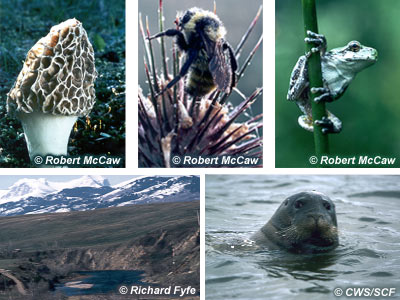
Clockwise from left:
- Morel
- Dew bumblebee on a teasel
- Gray treefrog
- Bearded seal, Wood Bay, N.W.T.
- Alpine, grassland, and shoreline ecosystems at Castle River, Alberta
Diversity is a characteristic of life everywhere on Earth, from the ocean floor to inside the human gut, and at every geographical scale, from the global to the microscopic. We see this diversity around us every day. We see genetic traits in people, in our pets, and in plants. We know, firsthand if we are lucky, the rich variety of mammal, bird, fish, and plant species in the world. And some of us have lived in strikingly diverse ecosystems—in coastal forests and on arctic tundra, in cities and on farms. However, all this is only a small part of the diversity of life.
Remarkably little is known about biological diversity. One reason is that most species—and many ecosystems—are a lot smaller than humans. Furthermore, each species, whether a tiny virus or a huge humpback whale, has its own genetic diversity, which, in an average species, involves millions of different pieces of genetic material. And to map the genetic code of even one species is an enormous undertaking.
About 1.6 million of the world’s species have been described. Estimates of the total number of species range from 12 to 118 million. The numbers for known and total estimated species are continually being revised. Viruses are almost entirely unknown. About one million of the known 1.6 million species are insects, and millions of insect species are still unclassified. Some 360 000 algae, fungi, and vascular plants, or those with conducting tissues, such as flowers, grasses and trees, have already been described, but botanists estimate that there are at least another million left to be classified. Animals like nematodes (e.g., worms) and crustaceans (e.g., shrimplike animals) are not well known.
Our knowledge of mammals and birds is much more complete, but species previously unknown to science are occasionally discovered. For example, a new primate, the black-faced lion tamarin, was found in 1990, and a new whale, the pygmy beaked whale, in 1991. And as scientists probe unexplored areas of the planet, they continue to find new species, all with unique gene pools, belonging, in some cases, to hitherto unknown ecosystems. Thanks to deep-sea vessels and cameras, bacteria and higher life forms (e.g., worms) have recently been discovered in the ultra-hotwater vents, kilometres below the ocean surface, where no life was thought to be possible.
You do not need to visit exotic places, however, to see strange, unknown organisms and unfamiliar ecosystems. A look through a microscope at ordinary soil reveals countless (mostly nameless!) microorganisms, in addition to the worms and insects that can be seen with the naked eye. Figure 1 shows a few of the underappreciated life forms found in the soil of a deciduous forest in eastern Canada. The oribatid soil mite shown in the drawing is one of the most common soil mites in Canada, but it has not yet been scientifically studied or given a scientific name. Soils are, in fact, complex ecosystems. For example, fungi on tree roots help trees absorb nutrients. And without the insects, fungi, earthworms, and bacteria that transform dead plants and animal carcasses into soil, piled up dead matter would quickly smother all but a few strong-growing trees and bushes!
Wildlife, defined as all wild species, makes up most of the species and genetic diversity of life. Wildlife includes more than mammals and birds living in wilderness areas. Each form of virus, soil organism, plankton, and insect, no matter where it lives, is a wild species, as are the species of parasites and microorganisms that live in such places as under human fingernails and on the feather shafts of wild birds. The remainder of species diversity, apart from the human species, is life forms that we have domesticated: e.g., species and cultivars of crops and garden plants and species and breeds of pets and livestock. However, despite their importance to people and their sometimes huge populations, domesticates account for only a tiny fraction of the millions of existing species and of the genetic diversity within species.
Some people refer to regional ecosystems that seem to have developed without human dominance as “natural” or “evolved” ecosystems: Canadian examples are the ancient temperate rain forest ecosystem on Vancouver Island and an ecosystem found on the untrawled ocean floor. Today, natural ecosystems and “wild lands and waters” (i.e., ecosystems in which humans and wild populations coexist) have become small arks holding a large proportion of the variety of the world’s species and genes, often in small populations.
Why is it important?
Why is it important that life remain diverse?
For its own sake
The Convention on Biological Diversity recognizes the intrinsic value of biodiversity. Each life form and ecosystem has its own intrinsic value, apart from any actual or potential usefulness to people. When a species goes extinct, it never returns.
To sustain life as we know it
We, like all species on Earth, are utterly dependent on the planetary environment. Species and ecosystems provide life-sustaining services, such as maintaining adequate oxygen in the atmosphere, removing carbon dioxide from air, filtering and purifying water, pollinating plants, breaking down waste, and transferring nutrients. Most ecosystems that evolved to provide these services can cope with some loss of diversity: for example, when a species becomes extinct, a new species may step in to take over its role in the ecosystem.
But there are limits to the protection that this flexibility provides. When species that cannot be replaced are lost, the whole assemblage of species may change, and rare species and their genes may disappear. Nor can this flexibility protect ecosystems against excessive modifications to harness their productivity strictly for human purposes. For example, the dustbowl on the prairies in the 1930s resulted in part from the ploughing up of native prairie grasses with massive soil-anchoring roots. Ploughing transformed the prairie grassland ecosystem. The plants and animals that were adapted to periodic drought were displaced. The new ecosystem, based on crops planted by people, provided social and economic benefits in wet years. In dry years, the soil simply blew away. Erosion of valuable topsoil still occurs and is a serious problem.
Furthermore, most Canadians develop a great aesthetic appreciation of nature as it exists and do not want to be deprived of it. Canadians of many backgrounds place spiritual value on animals, plants, and ecosystems. Canadians do not wish to leave a biologically impoverished Earth to their children and grandchildren.
“If the biota, in the course of aeons, has built something we like but do not understand, then who but a fool would discard seemingly useless parts? To keep every cog and wheel is the first precaution of intelligent tinkering.” — A. Leopold. 1966. A Sand County Almanac, Oxford University Press. New York. p. 177.
Insurance for the future
Maintaining the full range of the Earth’s biodiversity means maintaining the flexibility to respond to unforeseen environmental conditions. For example, many of Canada’s native plant species must endure both hot summers and cold winters. These plants may, therefore, have genetic material that could be used to develop agricultural crops that can withstand greater than normal temperature ranges.
Because natural ecosystems have stood the test of time, we can use them as models of sustainability. As long as we conserve them, we can return to them to learn how to refine or reengineer the croplands, managed forests, and industrial fishing areas that we have created, or to find the genes, species, or microecosystems that were left out of the human-designed system because we were ignorant of their importance.
Long-term human health and prosperity
Preserving biodiversity will also maintain our potential as a country to be creative and productive and will provide opportunities for discovering and developing new foods, medicines, and industrial products. Because other species face some of the same biological problems as we do and share the same “genetic alphabet,” the biochemical evolution that has been occurring in their populations through millions of generations has produced substances of great usefulness to people. For example, doctors use hirudin, a substance discovered in the saliva of leeches, to dissolve dangerous blood clots. Canada’s 138 native tree species have at least 40 recorded pharmaceutical or medical uses, and they are currently used for rayon, cellophane, methyl hydrates, glue, and turpentine.
How is it changing?
Global changes
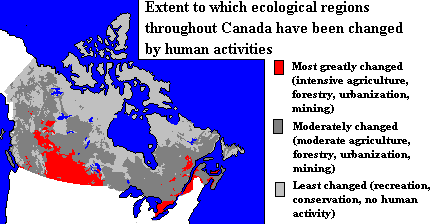
This map was prepared by the State of the Environment Directorate, based on a system used by Environment Canada to classify Canada’s ecosystems. The country’s land and ocean ecosystems have been summarized at various levels. The largest category is ecozones; these are subdivided into ecoregions; ecoregions are made up of ecodistricts, and so on.
Species go extinct in the normal course of evolution. But the rate of extinctions in the world has greatly increased in recent centuries because of the activities of the huge and growing number of people. The human population now appropriates 20 to 40 percent of the solar energy captured by land plants, leaving less for all other species. E.O. Wilson, a world expert on biodiversity, has calculated that, due to the reduction in area of the tropical rain forests alone, making no allowance for overhunting or invasion by alien organisms, today’s rate of extinction of species is 1 000 to 10 000 times the rate suggested by the fossil record, which was about one species per million species a year.
Many whales and dolphins are threatened. Roughly 116 of the world’s 200 species of apes and monkeys are threatened with extinction. And when larger animals go extinct, so, too, does a universe of microscopic organisms that lived on their bodies and waste materials.
The world’s grassland ecosystems have, for the most part, already been converted to crops or pasture. Temperate forests have been logged over and fragmented by roads, railways, and power corridors, which improve access for wild and domestic predators, people, and invasive species, resulting in disruption of ecological processes. More recently, species-rich tropical rain forest ecosystems have been greatly reduced in area. Wetlands continue to be drained for agriculture and urban expansion. Coral reefs may be in worse condition than either forests or wetlands. Wild lands and waters, and even stringently protected wilderness areas, are vulnerable to oil spills, acid rain, sedimentation, radioactive dust, long-lasting toxic chemicals, and invasive plants and nonnative animals.
Canadian losses
The greatest threat to biodiversity in Canada is the extensive alteration by people of a number of ecological regions, largely because of competing land uses such as agriculture and urbanization. The map shows which areas of Canada people have altered the most. The prairies and southern Ontario have been greatly transformed. Only a few hectares of the tallgrass prairie remain intact, and southern Ontario’s Carolinian forest survives only in scattered woodlands. Old-growth forests exist only in patches in the three Maritime provinces, only small stands of old red and white pines remain in central Canada, and the unlogged temperate west coast rain forest keeps shrinking.
In settled parts of Canada, wetlands, which are am ong the habitats richest in species, have been reduced by as much as 90 percent, and drainage, at least on private lands, shows little sign of abatement. Despite legislation to curb acid precipitation, it is predicted that we will continue to lose the fish, shellfish, and amphibian communities of thousands of small lakes in eastern Canada. The Great Lakes ecosystem has been greatly altered by intensive fishing and successive invasions of species, some deliberately introduced to create recreational fisheries, combined with other stresses, such as pollution and alteration of habitat. In Atlantic coastal waters, there has been a considerable reduction of genetic diversity in populations of northern cod, as well as the depletion of stocks of most food fishes.
Most of the species native to these regions at risk still exist in Canada, but their populations have been greatly reduced or fragmented. In some cases, this has already reduced the genetic diversity within species, which gives species the best chance to adapt to future stresses through selection. For example, the 12 or 13 forms of lake trout in Lake Superior have been reduced to only two or three.
Because most Canadian species are widely distributed, we have lost relatively few known species compared with tropical regions. Since about 1750, Canada has lost the Great Auk, Passenger Pigeon, Labrador Duck, Dawson caribou, sea mink, Banff longnose dace, deepwater cisco, longjaw cisco, and blue walleye. We do not know exactly how many more wild species are in danger of a similar fate, because we have not studied all Canadian wildlife.
While these losses have been going on, Canada has also been gaining species. A number of wild species that now form an integral part of our fauna or flora were deliberately introduced, such as the European Starling and several ornamental plants. Others were accidentally imported and in some cases have proved exceedingly difficult and costly to control, such as wild oats, zebra mussels, and the fungus responsible for Dutch elm disease. It is prudent not to create conditions that will result in our own native species being displaced.
What can we do?
What can we do to protect biodiversity?
It is important to prevent further losses. The geological evidence suggests that biodiversity does not recover quickly. Fossils indicate five previous major periods of extinction, the most recent being the extinction of the dinosaurs. After each previous extinction event it appears to have taken millions of years for life to regain former levels of diversity.
A global effort
The United Nations Convention on Biological Diversity, which Canada played a leading role in developing, provides an opportunity for countries to work in partnership on this complex global issue. It supports those working for sustainable development in all signatory countries.
The convention addresses daunting global challenges: protection of wilderness, management of other areas for diversity, sustainable use of the components of biodiversity, and equity between rich and poor countries in sharing the costs and benefits of conserving the Earth’s biological wealth.
How can we conserve biodiversity in Canada?
We must continue to survey our country’s flora and fauna to learn what exists and what needs protection.
We can continue to set aside areas, such as parks and ecological preserves, where activities disruptive to ecosystems or harmful to wildlife are not allowed. The federal, provincial, and territorial governments are committed to protecting areas representative of Canada’s terrestrial and marine natural regions and have instituted policies to try to protect and restore critical wildlife habitats.
Canada has a program to identify and rehabilitate species known to be critically endangered. We should continue to regulate hunting, fishing, and logging and to control the use of toxic chemicals. Canadian laws require the planners of large projects, like dams, to assess the likely consequences of their proposed projects on the environment before the final decisions to proceed are made.
We need to determine the scale at which biodiversity should be conserved and carry out broad-scale landscape planning. We can’t have a moose in every backyard, or Bald Eagles nesting near every pond.
One of the most crucial and potentially rewarding tasks is the study of wild areas and species. One of the things we must learn is how to extract income from wild lands and waters without damaging them. In Canada, trapping fur-bearing animals, hunting, collecting seaweed, fishing, tapping maple trees for syrup, logging in ecologically sound ways, and gathering (e.g., wild foods, medicines, craft materials) can all generate incomes from wild lands and waters in a sustainable fashion.
All Canadians have a role to play in maintaining biological diversity at present levels. We do not have to stop fishing, farming, logging, and building cities in order to preserve biodiversity, but we do have to limit these activities or at least do them in ways that are compatible with native ecosystems. This often means reintroducing native species to increase biodiversity on farmland, in forest plantations, in rivers, and even in cities.
In 1995, to meet Canada’s obligations under the Convention on Biological Diversity, Canada published the Canadian Biodiversity Strategy, and in 1996, all provinces and territories and the federal government signed a National Statement of Commitment to conserve biodiversity and use biological resources in a sustainable manner. Each jurisdiction is responsible for its own biodiversity conservation plan. Information on current activities is available from:
The Biodiversity Convention Office
Environment Canada
Ottawa, Ontario
K1A 0H3
Phone: (819) 953-4374
bcoweb@ec.gc.ca
Figure 1: A few of the small organisms in the soil ecosystem of a deciduous forest in eastern Canada
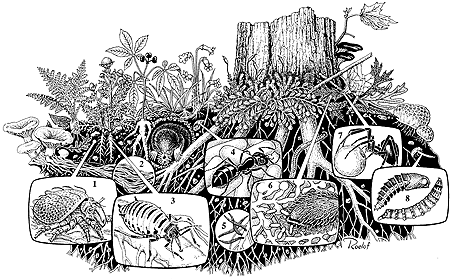
Drawing by Roelof Idema. Specimens and research courtesy of staff at the Canadian National Collection of Insects and Arachnids, Agriculture and Agri-Food Canada.
- Oribatid soil mite. The mite is magnified about 165 times (165x).
- Symbiotic union between the fungal hyphae of the fleecy milk cap and the roots of an oak tree (13x).
- Root aphid feeding on pineapple weed (22x).
- Oak forest ant tending eggs (7x).
- Nematodes (roundworms) feeding on roots (22x).
- Leaf decomposition by bacteria and fungal hyphae, with a protozoan ciliate feeding on the bacteria (1500x).
- Black widow spider tending an egg sac (2x).
- Predacious horsefly larva and pupa (1.5x)
Resources
Online resources
Convention on Biological Diversity
Print resources
Biodiversity: journal of life on Earth. Quarterly journal. Published by Tropical Conservancy, 94 Four Seasons Drive, Nepean, Ontario, K2E 7S1.
Bocking, S., editor. 2000. Biodiversity in Canada: ecology, ideas, and action. Broadview Press, Peterborough, Ontario.
Canadian biodiversity strategy: Canada’s response to the Convention on Biological Diversity. 1995. Available from the Biodiversity Convention Office, Environment Canada, Ottawa.
Mosquin, T., and P.G. Whiting. 1992. Canada country study of biodiversity: taxonomic and ecological census, economic benefits, conservation costs, and unmet needs. Canadian Centre for Biodiversity, Canadian Museum of Nature, Ottawa.
Tuxill, J. 1998. Losing strands in the web of life: vertebrate declines and the conservation of biological diversity. Worldwatch Paper 141. Worldwatch Institute, Washington, D.C.
Tuxill, J. 1999. Nature’s cornucopia: our stake in plant diversity. Worldwatch Paper 148, Worldwatch Institute, Washington, D.C.
Wilson, E.O. 1992. The diversity of life. The Belknap Press of Harvard University Press, Cambridge, Massachusetts.
© Her Majesty the Queen in Right of Canada, represented by the Minister of the Environment, 1995, 2002. All rights reserved.
Catalogue number CW69-4/92-2002E
ISBN 0-662-31460-3
Text: S.P. Burns and J.A. Keith
Revision: Susan Burns, 2001



